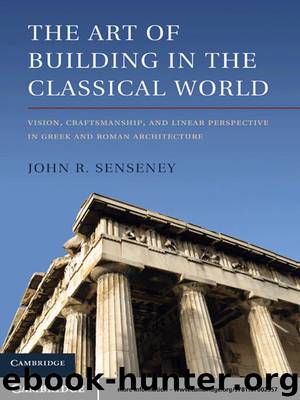The Art of Building in the Classical World by John R. Senseney

Author:John R. Senseney
Language: eng
Format: epub
Publisher: Cambridge University Press
Published: 2011-05-08T16:00:00+00:00
78 Artemision and agora, Magnesia-on-the-Maeander. Restored ground plan showing W. Hoepfner's proposed geometric underpinning. Drawing author, modified from W. Hoepfner, in Hermogenes: Figure 1.
integral to the visual experience of the building. If Archaic and Classical temples employed ichnography, by contrast, they did so in ways that one cannot readily appreciate in a manner that connects the experience in three dimensions to the instruments and methods of technical drawing that produced them. Yet in the Greek theater (Figure 77), the radial construction with the compass and straightedge establishes the rising forms of the koilon and its aisles.
The invention of this new form for theaters introduced a similarly new way of shaping all buildings according to the craft of technical drawing by way of ichnography – a progeny that transcended the theater as an isolated type. The round building at Delphi (Figure 38), with its circular placement of twenty columns, represents a protraction of the same radial arrangement of the fluting of its Doric columns. In a less internally coherent way, the round temple by the Tiber repeats the Delphic building's 3:5 diameters as well as its arrangement of twenty columns,62 even though the columns of this Roman building now feature the twenty-four divisions of the Corinthian order. Beyond circular buildings specifically, the use of ichnography to guide the total design of buildings extended to traditional rectilinear temples as well (Figures 23, 81). Furthermore, the radial and axial approach to designing theaters could even extend to the designing of relationships across voids within and between complexes, as in the binding of the sanctuary of Artemis Leukophryne and the neighboring agora in Magnesia-on-the-Maeander (Figure 78).63 In a fascinating way, therefore, the graphic means of shaping space begins as a way of articulating the plastic surfaces of columns in traditional buildings, which themselves existed as self-contained, sculptural expressions. With the aid of Vitruvius and the Greek sources his writing reflects, the principles that drove such processes of design in individual temple buildings and ultimately their settings are explored in the following chapter.
Download
This site does not store any files on its server. We only index and link to content provided by other sites. Please contact the content providers to delete copyright contents if any and email us, we'll remove relevant links or contents immediately.
Kathy Andrews Collection by Kathy Andrews(11726)
The remains of the day by Kazuo Ishiguro(8818)
Paper Towns by Green John(5087)
Spare by Prince Harry The Duke of Sussex(5072)
The Body: A Guide for Occupants by Bill Bryson(4974)
Industrial Automation from Scratch: A hands-on guide to using sensors, actuators, PLCs, HMIs, and SCADA to automate industrial processes by Olushola Akande(4972)
Machine Learning at Scale with H2O by Gregory Keys | David Whiting(4172)
Be in a Treehouse by Pete Nelson(3942)
Never by Ken Follett(3788)
Harry Potter and the Goblet Of Fire by J.K. Rowling(3772)
Goodbye Paradise(3726)
Into Thin Air by Jon Krakauer(3308)
The Remains of the Day by Kazuo Ishiguro(3293)
The Cellar by Natasha Preston(3259)
The Genius of Japanese Carpentry by Azby Brown(3223)
Fairy Tale by Stephen King(3216)
120 Days of Sodom by Marquis de Sade(3177)
Drawing Shortcuts: Developing Quick Drawing Skills Using Today's Technology by Leggitt Jim(2996)
The Man Who Died Twice by Richard Osman(2995)
